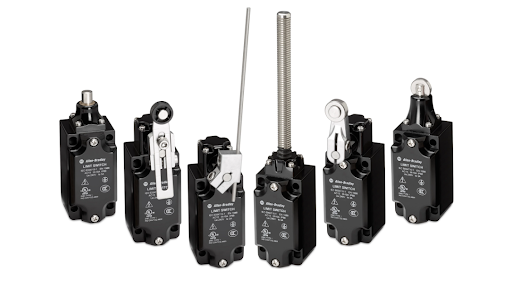In the realm of industrial automation and machinery, limit switches play a pivotal role in ensuring both operational safety and equipment reliability. These seemingly simple components are integral to controlling machinery functions, preventing damage, and maintaining system integrity. This blog delves into how switches enhance safety and contribute to long-term reliability in various applications.
Understanding Limit Switches
Switches are electromechanical devices designed to detect the presence or absence of an object, or the position of a moving part. They operate by physically interacting with a moving object to activate or deactivate an electrical circuit. The basic principle behind a limit switch involves a mechanical actuator that moves in response to the movement of machinery, triggering an electrical response that controls the system’s operation.
These switches are commonly used in industrial settings to provide feedback to control systems about the position of machinery components. This feedback is crucial for automating processes, managing machine movements, and ensuring that equipment operates within safe parameters. The reliable operation of switches helps prevent accidents and prolongs the lifespan of machinery by ensuring that components are not subjected to conditions beyond their designed limits.
Enhancing Safety with Limit Switches
Safety is a primary concern in any industrial environment, and switches contribute significantly to maintaining a safe working atmosphere. By monitoring and controlling the position of moving parts, switches prevent machinery from operating outside of predefined safe zones. This function is particularly important in automated systems where human intervention is minimal, and precise control is necessary.
For example, in a conveyor system, switches can be used to detect when items reach the end of the conveyor belt. By ensuring that the conveyor stops automatically when items are in the correct position, these switches help prevent jams and potential damage to the equipment. Similarly, in lifting systems, switches ensure that the load does not exceed safe height limits, reducing the risk of mechanical failure and potential hazards.
In addition to protecting machinery, switches also enhance worker safety. They can be configured to shut down machinery in emergency situations or if a safety guard is opened. This automatic response helps prevent accidents that could occur if machinery were to operate in an unsafe condition.
Ensuring Long-Term Reliability
The long-term reliability of industrial equipment is heavily dependent on the functionality of limit switches. Regular maintenance and proper functioning of these switches are essential for ensuring the continued efficient operation of machinery. Faulty or worn-out switches can lead to operational issues, such as unexpected machinery movements or failure to stop, which can result in costly repairs and downtime.
One of the key factors in maintaining reliability is selecting the right type of limit switch for the specific application. There are various types of switches, including mechanical, proximity, and optical switches, each with its own advantages and suitability for different environments. For instance, mechanical lswitches are known for their robustness and simplicity, making them ideal for harsh industrial environments, while proximity switches offer non-contact detection, reducing wear and tear.
Proper installation is also crucial for the long-term reliability of switches. Ensuring that switches are correctly aligned and securely mounted prevents mechanical wear and reduces the likelihood of malfunctions. Regular inspection and maintenance, including cleaning and adjusting the actuator, are necessary to keep switches functioning optimally. Implementing a maintenance schedule helps identify potential issues before they lead to equipment failures, thus minimising downtime and extending the lifespan of both the switches and the machinery.
Applications of Limit Switches
Switches find applications across a wide range of industries, including manufacturing, automotive, aerospace, and robotics. In each of these fields, their role in controlling and monitoring machinery is indispensable. For instance, in the automotive industry, switches are used to ensure that assembly line robots operate within safe limits, and in the aerospace sector, they help manage the precise movement of components during aircraft assembly.
In robotics, switches provide critical feedback to control systems, allowing robots to perform tasks with high precision. By accurately detecting the position of robotic arms and other moving parts, switches help ensure that robots operate within their designed parameters, improving overall system performance and safety.
Selecting the Right Limit Switch for Your Needs
Choosing the appropriate limit switch for a specific application involves considering various factors, including the operating environment, the type of machinery, and the required accuracy. Different types of switches, such as mechanical, magnetic, and optical, offer varying levels of sensitivity and durability. Mechanical switches, for instance, are highly durable and suitable for harsh environments, while magnetic and optical switches provide non-contact operation, which reduces wear and extends their lifespan.
When selecting a limit switch, it’s important to assess the environmental conditions it will be exposed to, such as temperature extremes, humidity, and potential exposure to corrosive substances. Additionally, the size and design of the switch should match the mechanical constraints of the application. Consulting with experts and conducting thorough evaluations can help ensure that the chosen limit switch meets the specific needs of the system and contributes to its overall reliability.
Conclusion
Limit switches are more than just small components; they are vital elements that enhance both safety and reliability in industrial systems. Their ability to control machinery movements and provide feedback to control systems helps prevent accidents and extend the lifespan of equipment. By understanding the role of switches and ensuring their proper installation and maintenance, industries can achieve safer and more reliable operations. As technology advances, the evolution of switches will continue to play a crucial role in the ongoing quest for efficiency and safety in automated systems.

